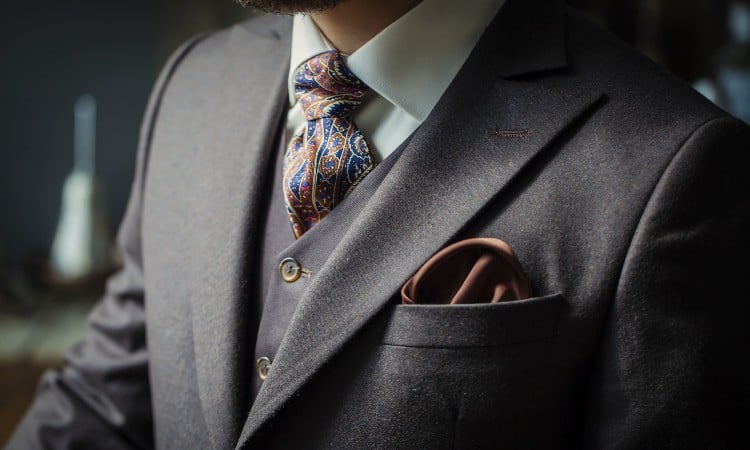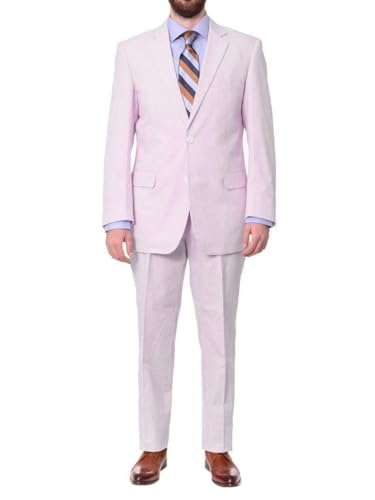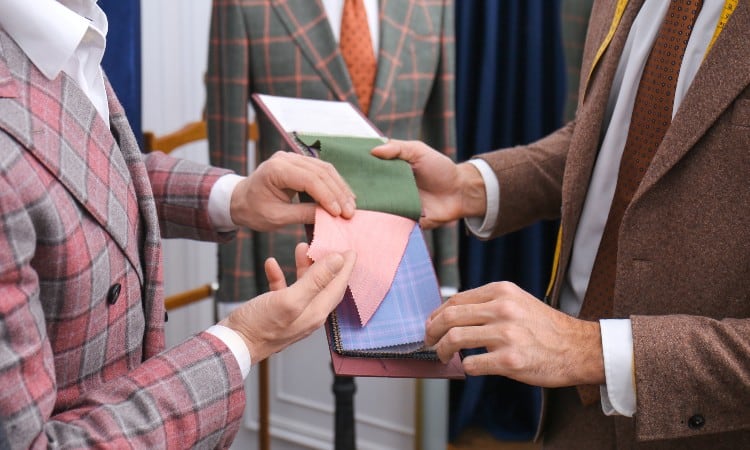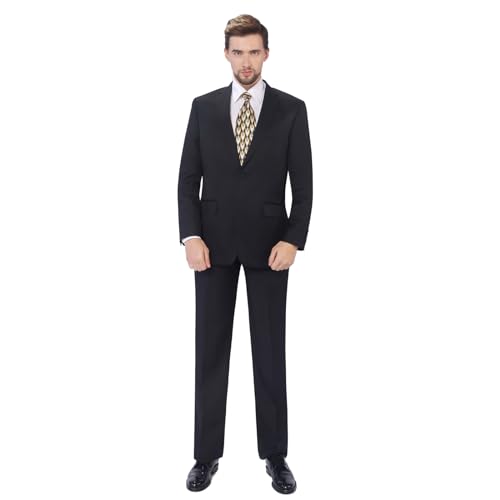You can wear a suit to look classy, professional, artsy, or scholarly. Imagine wearing a bespoke cashmere suit to the office, and then picture yourself in a red velvet smoking jacket instead! The type of fabric your suit is made of makes a strong statement, so choosing the best fabric for suits is essential.
The best fabric for suits is wool woven in many popular patterns, including herringbone, twill, houndstooth, and sharkskin. Wool provides breathability and softness, key qualities in a suit. Cotton, linen, velvet, and silk also make popular styles of suits for specific occasions.
In this article, you will find out what defines a good suit fabric. You will also learn the key characteristics of the most popular types of suiting fabric. Finally, you will get clued into the controversy over synthetic suits.

8 Best Fabrics for Suits
The most popular types of fabric for suits have several key characteristics, such as softness and breathability for comfort and an elegant drape for style! In this section, you will find all the basic info you need about the eight most popular types of suiting material.
1. Cashmere
 Cashmere is a kind of wool that comes from the soft under-hair of a particular kind of goat native to Mongolia. It has an incredibly soft texture, great water resistance, and excellent breathability. You can find cashmere suits in lighter or heavier weaves suitable for varying temperatures.
Cashmere is a kind of wool that comes from the soft under-hair of a particular kind of goat native to Mongolia. It has an incredibly soft texture, great water resistance, and excellent breathability. You can find cashmere suits in lighter or heavier weaves suitable for varying temperatures.
With the possible exception of some types of alpaca wool, cashmere is the softest kind of wool in the world and one of the softest fabrics as well! Because of its rarity, this material costs a lot, though. Cashmere is considered a luxury material.
Cashmere can last many, many years with proper care. It also insulates even better than most sheep’s wool, making it an ideal material for cold-weather suits. Plus, it has a lustrous appearance and drapes elegantly for pants!
If everyone could afford cashmere, it might quickly become the most popular material for suits.
| Pros | Cons |
|
|
2. Cotton
 Cotton suits feel light and soft and have excellent breathability. They have a casual, comfortable air about them that works well for outdoor events in the fall and summer. Because cotton doesn’t have great insulating properties, this fabric doesn’t make the best winter suit jackets.
Cotton suits feel light and soft and have excellent breathability. They have a casual, comfortable air about them that works well for outdoor events in the fall and summer. Because cotton doesn’t have great insulating properties, this fabric doesn’t make the best winter suit jackets.
Cotton suits don’t look very formal, as their thinner weave can fold over, wrinkle, or collapse easily instead of holding a stylish line against your body. That said, this material has incredible breathability and feels light and comfortable even in extreme heat!
You will have to press your cotton suit frequently because it won’t drape as elegantly as wool or linen. That said, cotton suits often cost far less than wool, so you may find this an affordable option for a stylish summer look!
| Pros | Cons |
|
|
3. Linen
 Linen suits have a loose weave and a natural, slightly nubbly texture. This fabric provides a perfect option for hot weather suits. Linen’s looser, lightweight weave can keep you cool even in extreme temperatures!
Linen suits have a loose weave and a natural, slightly nubbly texture. This fabric provides a perfect option for hot weather suits. Linen’s looser, lightweight weave can keep you cool even in extreme temperatures!
Linen clothes wrinkle; you can’t avoid this! Fortunately, a slightly crumpled linen look has its own stylish appeal. Think of an elegant billionaire lounging on his yacht in the Mediterranean wearing a silk shirt and a linen jacket!
Though linen does have a casual, stylish appearance, it still looks more suitable for casual occasions than a formal setting.
Linen comes from flax plants, which offer a far more sustainable option than growing cotton. The only downside to this comfortable summer fabric is that it does cost a lot more than cotton.
| Pros | Cons |
|
|
4. Silk
 Every suit says a lot about your style, but silk suits, in particular, tend to send a certain message. They are usually reserved for particular occasions or specific settings, like going out to a club or attending a fancy party. That said, you will find many high-end suits that use a blend that includes a high percentage of silk fibers.
Every suit says a lot about your style, but silk suits, in particular, tend to send a certain message. They are usually reserved for particular occasions or specific settings, like going out to a club or attending a fancy party. That said, you will find many high-end suits that use a blend that includes a high percentage of silk fibers.
For example, blending wool and silk creates a uniquely smooth, lustrous fabric that drapes even better than plain wool or plain silk. Blended materials work so well that you don’t often see 100% silk suits these days.
That said, silk resists staining, does not wrinkle as much as cotton or linen, and has a remarkable airy lightness. Its super-fine threads create a uniquely soft and smooth weave that feels buttery soft against your skin.
Of course, silk is definitely a luxury material! It costs quite a lot to harvest pure silk from silkworms and then turns the silk thread into fabric. Silk also does not have the durability of many other fabrics because of its delicate nature.
| Pros | Cons |
|
|
5. Tweed
No products found.Tweed suits originated in England and remain popular in chilly climates because of their thick, bulky texture. Tweed fabric most typically uses wool from Irish sheep in a thick twill or herringbone weave that has a fuzzy surface. You can also find a lighter, shinier version of tweed made from silk.Tweed suits usually look appropriate for casual or semi-formal events. In some places, they make appropriate office wear, depending on your place of work! In others, they remain the purview of academic halls.
In America, tweed suit jackets often bring to mind an absent-minded professor with leather patches at the elbows of his jacket. However, in cold climates, tweed makes a great investment because it is so durable and warm.
Actual tweed made in England does often cost quite a bit, though you can count on your tweed jacket lasting for many years with proper care! The only other possible downside to this cozy suit material is that it does have a bulkier, less modern look.
| Pros | Cons |
|
|
6. Velvet
No products found.Traditionally made from silk, most velvet today contains synthetic material to make it more affordable. Velvet comes from a special weaving process that creates two layers of fabric sandwiched together and then slices them apart down the middle, creating the thick, plush nap of all the severed threads.The soft pile of velvet makes for a warm, comfortable winter jacket. Velvet has a bit of heft to it because of its thick pile, making it less suitable for hot weather wear.
In the past, it was acceptable to wear velvet smoking jackets at certain times of the day or to specific locations. These days, a velvet blazer fits in easily at many formal and black tie events. You can also stand out boldly by choosing a velvet jacquard with a raised pattern or a bright or daring color to complement your fashion choice!
For formal events, velvet goes with an elegantly fitted shirt and a silk tie. For a more casual look, you can pair your velvet blazer with a turtleneck sweater or silk shirt!
| Pros | Cons |
|
|
7. Wool
 By far the most popular all-natural suiting fabric, wool has an innate softness and breathability that makes it ideal for jackets in many different styles. This material does not wrinkle easily, has anti-microbial properties, and has amazing water resistance, though it isn’t entirely waterproof.
By far the most popular all-natural suiting fabric, wool has an innate softness and breathability that makes it ideal for jackets in many different styles. This material does not wrinkle easily, has anti-microbial properties, and has amazing water resistance, though it isn’t entirely waterproof.
You can wear wool in both hot and cold weather because it provides remarkable temperature regulating abilities. Of course, in warm weather, you would want to select a light wool fabric, while in cold weather, you might opt for a heavier fabric with a denser weave.
For suiting purposes, you typically find wool fabric made in two different styles. A woolen fabric uses yarns with fluffy, airy uncombed fibers with lots of tiny puffy ends breaking free. It feels more like sweater material and may have a scratchy texture.
Worsted wool, on the other hand, uses longer, more tightly twisted wool fibers to create a dense, more lustrous yarn and a smooth fabric. Most of the suits you see use worsted yarn woven in several popular different patterns.
Even this wonderful fabric has some downsides, though. Wool does cost a lot, depending on the brand and style of suit you prefer. Also, some types of wool can make a slightly bulkier-looking suit because it isn’t the lightest, thinnest fabric you could choose.
| Pros | Cons |
|
|
8. Worsted
 Worsted wool is the most popular material for high-end suits. Unlike the average wool, worsted wool has a smooth, soft finish without any fuzziness or sweater-like quality to it at all. It also has a soft texture and excellent breathability.
Worsted wool is the most popular material for high-end suits. Unlike the average wool, worsted wool has a smooth, soft finish without any fuzziness or sweater-like quality to it at all. It also has a soft texture and excellent breathability.
As you now know, wool manufactured in this style uses long, combed fibers twisted into dense yarns. These tightly twisted yarns create a smooth, sleek fabric. Better yet, worsted wool offers a light and supple feel that will not feel oppressive or constraining even after long hours at the office.
On top of this, worsted wool typically has a high “super number.” This describes how fine each yarn is. Luxury-quality worsted usually has a super number over 180, while on average, you would more likely find a super number of 100.
You can find worsted wool in varying weights, which describes the thickness or thinness of the fabric. For an elegant drape, you should go with a lightweight worsted. For added warmth, you may want the slightly bulkier option of a more heavy-weight worsted.
Wool suits look classy at the office and stylish in any semi-formal setting. Worsted wool also makes comfortable, sleek formal wear suits.
| Pros | Cons |
|
|
Luxury Suiting Fabrics
Luxury suiting fabrics reach way beyond the merely expensive fabrics like linen and worsted wool and shoot into stratospheric price ranges of anywhere from $10,000-$50,00 per suit! While this level of suit typically involves expensive bespoke tailoring, the true cost comes from the rarity of these luxury fabrics.
Most luxury suiting fabrics come from certain rare animals. These unique types of material have extremely limited production around the world, allowing manufacturers to set incredible prices.
Vicuña fabric comes from a type of llama found in the wilds of South America. This animal does not do well in captivity, so they live wild and have their soft underfur harvested once every three years. Vicuna hairs are the finest type of wool in existence, even finer than cashmere!
Some types of cashmere also fall into this extreme luxury classification, though these days, you have to watch out for cheaper products. Truly high-end, Grade A cashmere uses such fine goat hairs that they measure less than 14 microns in width! Cashmere provides one of the softest types of wool in the world, so you will never feel a scratchy thread if you can afford a cashmere suit!
Other rare animals like the qiviut and the guanaco also provide super rare, super soft under-hair that creates costly fabric. You don’t see this type of wool on the market in big box stores or even from retail fashion name brands, for sure!
Today, many luxury brands, high-end designers, and bespoke tailors also use a wide range of blended fabrics. These will often merge silk, rare wool, and less expensive wool made with super fine threads, for example. This kind of fabric can still cost a small fortune, but it has its own unique characteristics and style because it merges different fibers.
How to Choose the Right Suiting Fabric

The most important qualities of any suiting fabric are the fabric’s weight, its breathability and softness, and its type of weave. Of course, the cut and style of your suit play a role as well, but even a stylish cut won’t make up for using the wrong material!
You also need to consider the time of year and climate where you plan to wear the suit. For example, cotton will keep you cool during the spring and summer but will not keep you warm in chillier weather.
Finally, matching the suiting fabric to the appropriate occasion matters, too! Some fabrics traditionally look more appropriate in certain settings, while others have universal acceptability. Wool suits, for example, generally fit in anywhere.
Take a look at these key characteristics of suiting fabric to help you make a perfect choice!
Fabric Weight
Fabric weight can get confusing because different kinds of materials use different measurements. The key to this category is that usually, lightweight fabric works best for hot weather, and heavier-weight fabric will keep you warmer in cold weather.
Most types of material are measured in either grams per meter, called GSM, or in ounces per yard, called oz. These measurements describe how much a certain length of material weighs. Thicker yarns or a denser weave will weigh more than fine yards or a loose weave.
On top of this, you will often see the terms “light,” “medium,” and “heavy” weight thrown around. These do not necessarily have a scientific specificity, but they will give you a general idea of the thickness of the fabric. For example, tweed fabric is usually referred to as a heavyweight fabric, weighing in around 14 oz.
Does fabric weight matter aside from the hot and cold issue? Actually, yes. Fabric weight also plays a role in the drape and style of a suit.
Very thin fabric may not drape as well as a medium-weight fabric. For this reason, super fine wool may have too much softness, almost to the point of translucence. It may also wear out quickly or get shiny patches.
Likewise, a heavyweight fabric can have a stiff, stodgy look because it has too much bulk to drape easily.
Breathability
Breathability makes a world of difference in a classy and comfortable suit. You do not want to feel suffocated under multiple layers of material, so you need a fabric that allows air to flow through its weave, keeping your temperature comfortably regulated all day long!
Cotton and linen both have excellent breathability for summer wear. That said, most types of wool have remarkable breathability, too!
Technically, wool has excellent temperature regulating abilities. It responds to your body temperature, allowing the hot air to flow out when you feel overheated, and insulating you when you get chilled.
If you find yourself in a sweaty situation, cotton will absorb the moisture and display the sweat stains for a long time. Wool, on the other hand, will suck up the moisture and quickly dissipate it into the outside air!
Softness
No one wants to wear rough or scratchy clothes, so softness also matters a lot when choosing a suiting fabric!
The type of material will determine some of the softness in any fabric. For example, cashmere has an incredible softness and will always feel softer than sheep’s wool. This has to do with the natural fiber diameter of the material used to make fabric.
That said, other factors can impact a fabric’s softness as well. Higher thread count per square inch means that finer threads created the weave. This makes the fabric softer to the touch.
Cotton can have varying degrees of softness depending on its thread count, for example.
The fabric’s texture also makes it feel more or less soft. A fabric with a sleek, smooth surface, like silk, will always feel softer than a fabric with a prickly surface, like certain types of wool.
Type of Weave
The type of weave gives a piece of fabric its unique appearance. Popular weave patterns for suiting include houndstooth, twill, gabardine, herringbone.
What is a weave pattern? Well, when you think of weaving, you probably visualize a typical basketweave pattern, with threads crisscrossing each other at right angles. This basic plain weave, or over-under pattern, has many fancier competitors!
A houndstooth weave looks like many tiny dog heads with tall ears and sharp teeth, all interlocking like puzzle pieces! This effect happens when two different colors of thread in a twill weave build a broken check design.
A twill weave remains one of the most popular weaves for many types of suiting fabric. This pattern uses a diagonal rib design, often in two colors of thread. Denim uses a twill weave with blue and white threads, for example.
A gabardine weave has an elegant appearance created by a variation on the twill weave, using more warp than weft threads. It has a smooth back but a raised, diagonal pattern on the surface of the fabric.
You may sometimes see a herringbone weave referred to as a broken twill weave. It looks like twill, except that the lines in the diagonal pattern slant one way in one row and then the other way in the other row! This contrasting pattern has a unique visual appeal.
Popular Ladies Suit Fabric Types
Women’s suits typically feature styles that accentuate different body parts than men’s suits, but they use the same set of suiting fabrics. For example, worsted wool is also the most popular material used in high-end women’s suits.
That said, you will find that satin or silk suits, especially in a jacket and pencil skirt style, are a popular choice for women.
In terms of luxury fabrics, you can also find vicuna, cashmere, and high-end worsted wool available in women’s suits.
What is the Best Suit Fabric for Summer?
Linen, cotton, and lightweight worsted wool are the best suit fabrics for summer or warm weather wear.
When selecting a suit for the summer, you want a lightweight material that has a looser weave. Ideally, you should choose a very breathable material as well.
Cotton and linen have great breathability. Wool provides the best temperature regulation of any all-natural fiber, so nice lightweight wool can keep you cool as well!
The construction and style of the suit can also help keep you cool. You should go in an unlined suit jacket for hot weather, for example.
What’s Wrong with Polyester Suits?
 While nearly all mass-market retailers sell various polyester suits, high-end brands generally don’t use this fabric because its affordability gives it an air of cheapness. Polyester is an affordable synthetic material basically made out of plastic. Low-quality polyester suits do look sort of shiny, giving them a cheap look.
While nearly all mass-market retailers sell various polyester suits, high-end brands generally don’t use this fabric because its affordability gives it an air of cheapness. Polyester is an affordable synthetic material basically made out of plastic. Low-quality polyester suits do look sort of shiny, giving them a cheap look.
Now, textile sciences have advanced by leaps and bounds in the past decades, and some types of polyester can closely mimic many types of natural fabric. Polyester makes up more than half of all retail clothing sold around the world!
So really, the polyester suit issue is open for debate. If you want affordable suits, go for it! If you want a fancy brand and high-end quality, you’re going to need to dish out the dollars for an expensive all-natural material like wool.
You will also see a great deal of debate over whether or not polyester feels as soft and breathable as a natural fabric. Generally, cotton has a softer feel than 100% polyester. Likewise, wool has greater breathability.
It’s true that in fashion, like in life, you usually get what you pay for. But not everyone can afford a bespoke worsted wool suit, so there’s nothing wrong with picking out an elegant polyester suit to wear to the office, either!
Conclusion
The most popular suiting fabric is wool, closely followed by linen and cotton. When selecting the best suiting fabric for you, you should consider the softness, breathability, weight, and type of weave of the material. Some suiting fabrics have a distinctive appearance that makes them more suited for specific occasions as well.
Many ready-wear clothing brands sell polyester suits. These suits can have an attractive appearance and stylish cuts, but the synthetic fabric has a cheaper look than a classic suiting material like wool.
What fabric is your favorite suit made out of? Where do you like to wear it? Leave a comment below to let us know!